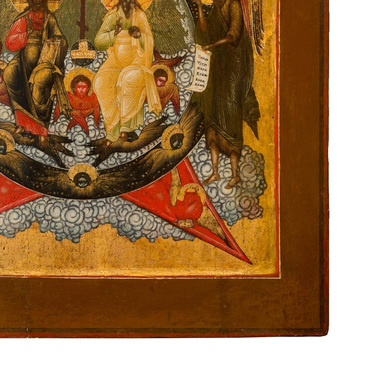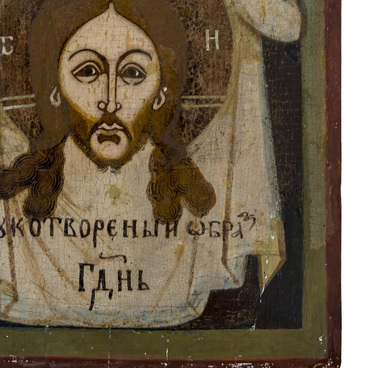The exhibition presents a medium-sized home icon, which the artist painted with oil paints directly on the icon board, without gluing the fabric lining (pavoloka) or applying primer in order to make it cheaper. A white stripe along the perimeter separates the narrow margins from the main image.
In the center near the table are three angels in robes of different colors, one of them addresses the forefather Abraham standing to the left. On the right, from behind the slightly open door, Sarah listens to their conversation. It is noteworthy that the angel addressing Abraham is depicted barefoot, while sandals are visible on Abraham’s feet. Abraham’s slightly forward-leaning posture conveys his feelings — surprise and reverence; his hands outstretched to the angels indicate that the dialogue has begun. The angel closest to the viewer points with the finger of his right hand at Abraham, while his open left hand is turned to Sarah standing outside the door. Above their heads, a strip of sky turns blue; below, from chest level, the blue color is replaced by grayish-brown ground.
This image illustrates chapter 18 of Genesis, which describes the appearance of the Holy Trinity to Abraham as three angels: “Then the Lord appeared to him by the terebinth trees of Mamre, as he was sitting in the tent door in the heat of the day.” Abraham was given to know Who was in front of him, so he addressed the newcomers with the word “My Lord”, offering them a treat. Therefore, the image is also called “The Hospitality of Abraham”. The Lord informed Abraham, who was almost a hundred years old, that his ninety-year-old wife Sarah would bear him a son, that he would give rise to ”…a great and powerful nation, and all nations on earth will be blessed through him.”
The iconography of “The Hospitality of Abraham” is
one of the oldest in Christian art: it is present in the paintings of the
catacombs of Rome of the 2nd — 4th centuries, and in the
mosaics of Ravenna. For many centuries, in many variations, it was the only
canonical image of the Trinity — one God existing in three coequal, coeternal
divine persons. Many centuries later, at the beginning of the 15th century, the Russian iconographer Andrei Rublev, who is canonized as a saint,
developed a new iconography for the “Hospitality” scene: he abandoned narrative
details, depicting only the Trinity — the angels themselves.


